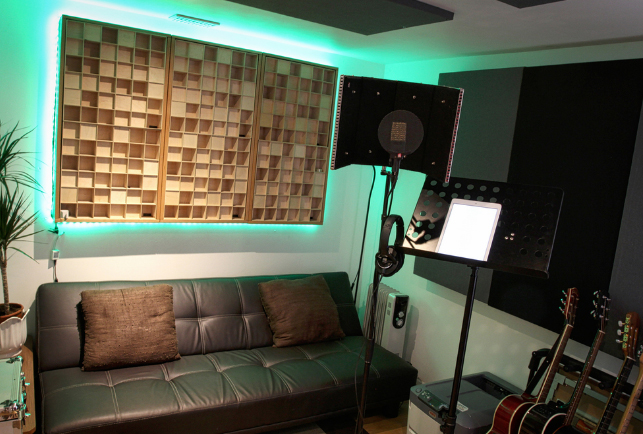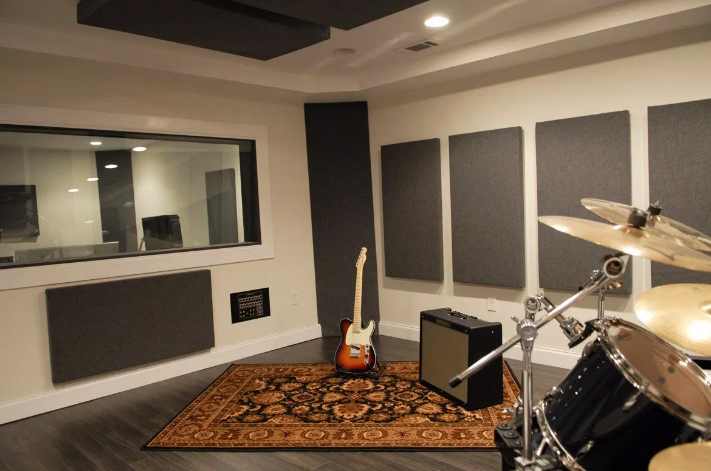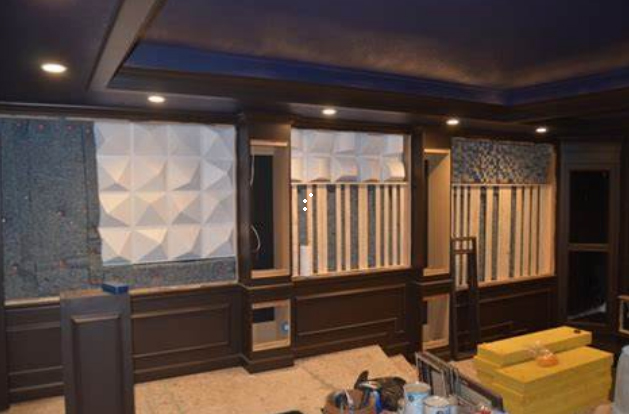acoustic treatment
¡¡
One of the biggest problems beginners have with home
recording is ...
That they seriously underestimate the importance of room acoustics ...
And suppose that with a good condenser microphone and expensive studio
monitors great sound comes on its own.
But in fact, the acoustics of your room have more to do with the sound
quality ...
Everything else in your studio ... everything else.
And so instead of doing months of frustration trying to figure out
what's wrong, you can take care of it right now.
And in this article I walk through the entire process step by step with
you on how to make an effective acoustic treatment of your home studio.
Ready? Let's get started. First ¡

Basic course acoustics
Before we begin with the acoustic treatment, it is helpful to have a
basic understanding of acoustics in general.
The good news is ... you do not need a degree in acoustics to operate a
recording studio.
You just have to be familiar with a few EASY CONCEPTS. First ¡

1. How sound propagates in a room
When a noise is caused in a room, the following happens:
Starting from the source, it spreads in all directions.
A small part (direct sound) comes in a straight line to the microphone.
The rest (reflected sound) is reflected from the surfaces in the room.
Shortly thereafter, some of these reflections reach the microphone.
Well ...

Since the direct sound does not interact with the space, the frequency
balance remains unchanged, the sound remains the same.
With reflected sound, each reflection can slightly change the original
sound.
Depending on the size of the room and the reflective surfaces ...
Can these changes be BIG or SMALL ... GOOD or BAD?
In most rooms they are bad. Why?
2. Why most rooms have bad acoustics
Cathedral Jakarta
Have you ever visited a large cathedral like the one in the picture?
Then you have noticed that every sound sounds absolutely incredible.
That's because such spaces were not just built to look good ...
But also and to sound nice.
The problem is ... to build rooms with good acoustics, it takes a lot of
space and a lot of money.
And since most of us do not have either ... we fake them like this:
3. How to fake a Great Room Tone
sun ox oxford reverb
Back in the 1960s ...
Did someone invent a fantastic tool, the reverberation room?
With this resource, sound engineer could simulate the reverberation of a
room that was NOT the recording room.
Over the years, the technology has become more mature and today ...
Can computer programs, with digital reverb / digital reverb, simulate
virtually any sound in any acoustic environment.
But you have to keep in mind: before you add FALSE Hall, you have to get
rid of the REAL Hall first.
And so:
4. How to remove the natural reverberation of a room
Auralex all in one package
Have you ever noticed the foam on the walls of recording studios?
He may look super cool ...
But his REAL task is to absorb sound reflections.
Usually these reflections are recorded ...
But with acoustic absorption, only the direct sound from the instrument
is left ... and that's exactly what we want.
This is what the "theory" looks like ...
But in practice, many people find that absorption works best when
combined with another type of acoustic treatment, diffusion.
And this is how it works ¡
5. How diffusion improves your sound
Auralex Sustain Bamboo Waveprism Diffuser
If you eliminate ALL sound reflections by absorption ...
Many feel the sound of the room as "dead".
The solution is ... to allow a few reflections and sprinkle them with
diffusers.
Usually, untreated reflections cause problems because they overlap at
one point, which amplifies some frequencies and wipes out others.
This destroys the natural frequency balance.
Diffusers scatter reflections so that there are no overlays and the
natural sound is preserved.
With the right combination of absorption and diffusion, you can change
the acoustics of virtually any room ... to the acoustics that allow you
to make world-class shots.
Now you know the basics of acoustics ... the NEXT step is to apply these
principles to your room by subjecting it to an acoustic treatment.
But first we clarify a misunderstanding that beginners often have ...
Soundproofing or Acoustic treatment?
acoustic barrier
Very often musicians confuse these two terms and use them synonymously
...
Although both describe something completely different.
Soundproofing is designed to reduce the sound coming in or out of your
studio:
By blocking with a heavy, dense building material,
By closing air holes in windows and doors.
The advantage here is ... You can take pictures when you want, without
worrying about you and your neighbors disturbing each other.
On the other hand, Acoustic Treatment ONLY has the goal of controlling
sound reflections WITHIN the studio to make better pictures.
BOTH procedures have their value, but NOTHING can do the job of another.
Soundproofing can definitely be planned as part of your acoustic
treatment, but technically it is not an acoustic treatment itself.
So if you want to know something about soundproofing, take a look at
this article:
The Ultimate Soundproofing Guide for Your Homestudio
Otherwise we continue ...
Evaluate your naked room
When beginners hear about the benefits of acoustic treatment for the
first time ...
Go too far too often and buy material without first diagnosing and
evaluating the extent of your problem.
So ... To find out how bad the acoustics really are in your room, do the
following:
Go through the room and clap at each point as loud as you can in the
hands and listen carefully to the reflections.
In the worst case, you'll hear a hard, metallic-sounding sound that
typically occurs in small cubic spaces.
In the best case you will hear a pleasant reverberation, which typically
occurs in large rooms with high ceilings and many different surfaces.
But you probably hear something in between.
The closer you are to # 1, the more absorption you need to make the room
sound as dry as possible.
The closer you are to # 2, the less acoustic treatment you need in
general, though virtually every room will benefit a bit.
If you need more reference points to see the difference between good and
bad acoustics, do the gossip text in many different rooms, and remember
which ones sound the best.
Later, when you start the acoustic treatment, keep doing the gossip test
to see how the sound changes.
With each new measure, the metallic sound should be less until it
finally disappears completely.
¡¡
¡¡